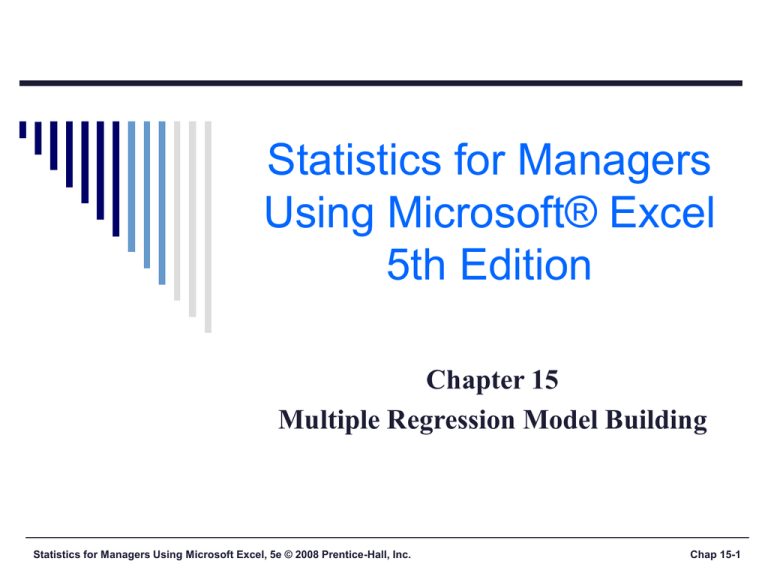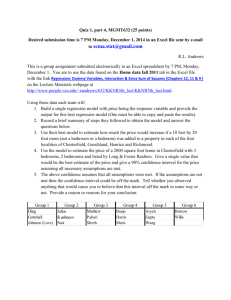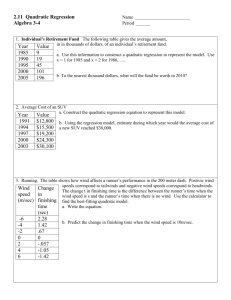here
advertisement

Statistics for Managers Using Microsoft® Excel 5th Edition Chapter 15 Multiple Regression Model Building Statistics for Managers Using Microsoft Excel, 5e © 2008 Prentice-Hall, Inc. Chap 15-1 Learning Objectives In this chapter, you learn: To use quadratic terms in a regression model To use transformed variables in a regression model To measure the correlation among independent variables To build a regression model, using either the stepwise or best-subsets approach To avoid the pitfalls involved in developing a multiple regression model Statistics for Managers Using Microsoft Excel, 5e © 2008 Prentice-Hall, Inc. Chap 15-2 Nonlinear Relationships The relationship between the dependent variable and an independent variable may not be linear Can review the scatter plot to check for nonlinear relationships Example: Quadratic model Yi β 0 β1X1i β 2 X1i2 ε i The second independent variable is the square of the first variable Statistics for Managers Using Microsoft Excel, 5e © 2008 Prentice-Hall, Inc. Chap 15-3 Quadratic Regression Model Model form: Yi β0 β1X1i β 2 X ε i 2 1i where: β0 = Y intercept β1 = regression coefficient for linear effect of X on Y β2 = regression coefficient for quadratic effect on Y εi = random error in Y for observation i Statistics for Managers Using Microsoft Excel, 5e © 2008 Prentice-Hall, Inc. Chap 15-4 Quadratic Regression Model Y Y X X residuals residuals X Linear fit does not give random residuals Statistics for Managers Using Microsoft Excel, 5e © 2008 Prentice-Hall, Inc. X Nonlinear fit gives random residuals Chap 15-5 Quadratic Regression Model Yi β0 β1X1i β 2 X ε i 2 1i Quadratic models may be considered when the scatter diagram takes on one of the following shapes: Y Y β1 < 0 β2 > 0 X1 Y β1 > 0 β2 > 0 X1 Y β1 < 0 β2 < 0 X1 β1 > 0 β2 < 0 X1 β1 = the coefficient of the linear term β2 = the coefficient of the squared term Statistics for Managers Using Microsoft Excel, 5e © 2008 Prentice-Hall, Inc. Chap 15-6 Quadratic Regression Equation Collect data and use Excel to calculate the regression equation: Ŷi b0 b1X1i b2 X1i2 Test for Overall Relationship H0: β1 = β2 = 0 (no overall relationship between X and Y) H1: β1 and/or β2 ≠ 0 (there is a relationship between X and Y) F-test statistic = MSR MSE Statistics for Managers Using Microsoft Excel, 5e © 2008 Prentice-Hall, Inc. Chap 15-7 Testing for Significance Quadratic Effect Testing the Quadratic Effect Compare quadratic regression equation ^ Yi b 0 b1X1i b 2 X1i2 with the linear regression equation ^ Yi b 0 b1X1i Statistics for Managers Using Microsoft Excel, 5e © 2008 Prentice-Hall, Inc. Chap 15-8 Testing for Significance Quadratic Effect Testing the Quadratic Effect Consider the quadratic regression equation ^ Yi b 0 b1X1i b 2 X1i2 Hypotheses H0: β2 = 0 (The quadratic term does not improve the model) H1: β2 0 (The quadratic term improves the model) Statistics for Managers Using Microsoft Excel, 5e © 2008 Prentice-Hall, Inc. Chap 15-9 Testing for Significance Quadratic Effect Testing the Quadratic Effect Hypotheses H0: β2 = 0 (The quadratic term does not improve the model) H1: β2 0 (The quadratic term improves the model) The test statistic is b2 β2 t Sb 2 d.f. n 3 Statistics for Managers Using Microsoft Excel, 5e © 2008 Prentice-Hall, Inc. where: b2 = estimated slope β2 = hypothesized slope (zero) Sb2 = standard error of the slope Chap 15-10 Testing for Significance Quadratic Effect Testing the Quadratic Effect If the t test for the quadratic effect is significant, keep the quadratic term in the model. Statistics for Managers Using Microsoft Excel, 5e © 2008 Prentice-Hall, Inc. Chap 15-11 Quadratic Regression Example 3 1 7 2 8 3 15 5 22 7 33 8 40 10 54 12 67 13 70 14 78 15 85 15 87 16 99 17 Purity increases as filter time increases: Purity vs. Time 100 80 Purity Purity Filter Time 60 40 20 0 0 Statistics for Managers Using Microsoft Excel, 5e © 2008 Prentice-Hall, Inc. 5 10 15 20 Time Chap 15-12 Quadratic Regression Example Simple (linear) regression results: ^ t statistic, F statistic, and Y = -11.283 + 5.985 Time 2 Coefficients Intercept Time adjusted r are all high, but the residuals are not random: Standard Error t Stat P-value -11.28267 3.46805 -3.25332 0.00691 5.98520 0.30966 19.32819 2.078E-10 Time Residual Plot Regression Statistics R Square 0.96888 Adjusted R Square 0.96628 Standard Error 6.15997 F 373.57904 Significance F 2.0778E-10 Residuals 10 5 0 -5 0 5 10 15 20 -10 Time Statistics for Managers Using Microsoft Excel, 5e © 2008 Prentice-Hall, Inc. Chap 15-13 Quadratic Regression Example Quadratic regression results: Coefficients Standard Error t Stat P-value Intercept 1.53870 2.24465 0.68550 0.50722 Time 1.56496 0.60179 2.60052 0.02467 Time-squared 0.24516 0.03258 7.52406 1.165E-05 Time Residual Plot 10 Residuals ^ = 1.539 + 1.565 Time + 0.245 (Time)2 Y 5 0 -5 0 5 10 15 20 Time Time-squared Residual Plot F R Square 0.99494 Adjusted R Square 0.99402 Standard Error 2.59513 1080.7330 Significance F 2.368E-13 The quadratic term is significant and improves the model: adjusted r2 is higher and SYX is lower, residuals are now random. Statistics for Managers Using Microsoft Excel, 5e © 2008 Prentice-Hall, Inc. 10 Residuals Regression Statistics 5 0 -5 0 100 200 300 400 Time-squared Chap 15-14 Using Transformations in Regression Analysis Idea: Non-linear models can often be transformed to a linear form Can be estimated by least squares if transformed Transform X or Y or both to get a better fit or to deal with violations of regression assumptions Can be based on theory, logic or scatter plots Statistics for Managers Using Microsoft Excel, 5e © 2008 Prentice-Hall, Inc. Chap 15-15 The Square Root Transformation The square-root transformation Yi β0 β1 X1i εi Used to overcome violations of the equal variance assumption fit a non-linear relationship Statistics for Managers Using Microsoft Excel, 5e © 2008 Prentice-Hall, Inc. Chap 15-16 The Square Root Transformation Yi β0 β1 X1i εi Yi β0 β1X1i ε i Shape of original relationship Y Relationship when transformed Y X Y b1 > 0 X Y b1 < 0 X Statistics for Managers Using Microsoft Excel, 5e © 2008 Prentice-Hall, Inc. X Chap 15-17 The Log Transformation The Multiplicative Model: Original multiplicative model Transformed multiplicative model Yi β0 X1iβ1 εi log Yi log β0 β1 log X1i log ε i The Exponential Model: Original multiplicative model Yi e β0 β1X1i β2 X2i εi Transformed exponential model ln Yi β0 β1X1i β2 X2i ln ε i Statistics for Managers Using Microsoft Excel, 5e © 2008 Prentice-Hall, Inc. Chap 15-18 Interpretation of Coefficients For the multiplicative model: log Yi log β0 β1 log X1i log ε i When both dependent and independent variables are transformed: The coefficient of the independent variable Xk can be interpreted as follows: a 1 percent change in Xk leads to an estimated bk percentage change in the mean value of Y. Statistics for Managers Using Microsoft Excel, 5e © 2008 Prentice-Hall, Inc. Chap 15-19 Collinearity Collinearity: High correlation exists among two or more independent variables The correlated variables contribute redundant information to the multiple regression model Statistics for Managers Using Microsoft Excel, 5e © 2008 Prentice-Hall, Inc. Chap 15-20 Collinearity Including two highly correlated independent variables can adversely affect the regression results No new information provided Can lead to unstable coefficients (large standard error and low t-values) Coefficient signs may not match prior expectations Statistics for Managers Using Microsoft Excel, 5e © 2008 Prentice-Hall, Inc. Chap 15-21 Some Indications of Strong Collinearity Incorrect signs on the coefficients Large change in the value of a previous coefficient when a new variable is added to the model A previously significant variable becomes insignificant when a new independent variable is added Statistics for Managers Using Microsoft Excel, 5e © 2008 Prentice-Hall, Inc. Chap 15-22 Detecting Collinearity Variance Inflationary Factor VIFj is used to measure collinearity: 1 VIFj 2 1 R j where R2j is the coefficient of determination from a regression model that uses Xj as the dependent variable and all other X variables as the independent variables If VIFj > 5, Xj is highly correlated with the other independent variables Statistics for Managers Using Microsoft Excel, 5e © 2008 Prentice-Hall, Inc. Chap 15-23 Model Building Goal is to develop a model with the best set of independent variables Easier to interpret if unimportant variables are removed Lower probability of collinearity Stepwise regression procedure Provide evaluation of alternative models as variables are added Best-subset approach Try all combinations and select the model with the highest adjusted r2 Statistics for Managers Using Microsoft Excel, 5e © 2008 Prentice-Hall, Inc. Chap 15-24 Stepwise Regression Idea: develop the least squares regression equation in steps, adding one independent variable at a time and evaluating whether existing variables should remain or be removed The coefficient of partial determination is the measure of the marginal contribution of each independent variable, given that other independent variables are in the model Statistics for Managers Using Microsoft Excel, 5e © 2008 Prentice-Hall, Inc. Chap 15-25 Best Subsets Regression Idea: estimate all possible regression equations using all possible combinations of independent variables Choose the best model by looking for the highest adjusted r2 The model with the largest adjusted r2 will also have the smallest SYX Stepwise regression and best subsets regression can be performed using Excel with PHStat add in Statistics for Managers Using Microsoft Excel, 5e © 2008 Prentice-Hall, Inc. Chap 15-26 Alternative Best Subsets Criterion Calculate the value Cp for each potential regression model Consider models with Cp values close to or below k + 1 k is the number of independent variables in the model under consideration Statistics for Managers Using Microsoft Excel, 5e © 2008 Prentice-Hall, Inc. Chap 15-27 Alternative Best Subsets Criterion The Cp Statistic (1 Rk2 )(n T ) Cp (n 2(k 1)) 2 1 RT Where k = number of independent variables included in a particular regression model T = total number of parameters to be estimated in the full regression model Rk2 = coefficient of multiple determination for model with k independent variables R 2T = coefficient of multiple determination for full model with all T estimated parameters Statistics for Managers Using Microsoft Excel, 5e © 2008 Prentice-Hall, Inc. Chap 15-28 8 Steps in Model Building 1. Choose independent variables to include in the model 2. Estimate full model and check VIFs and check if any VIFs > 5 If no VIF > 5, go to step 3 If one VIF > 5, remove this variable If more than one, eliminate the variable with the highest VIF and repeat step 2 3. Perform best subsets regression with remaining variables. 4. List all models with Cp close to or less than (k + 1). Statistics for Managers Using Microsoft Excel, 5e © 2008 Prentice-Hall, Inc. Chap 15-29 8 Steps in Model Building 5. Choose the best model. Consider parsimony. Do extra variables make a significant contribution? 6. Perform complete analysis with chosen model, including residual analysis. 7. Transform the model if necessary to deal with violations of linearity or other model assumptions. 8. Use the model for prediction and inference. Statistics for Managers Using Microsoft Excel, 5e © 2008 Prentice-Hall, Inc. Chap 15-30 Model Validation The final step in the model-building process is to validate the selected regression model. Collect new data and compare the results. Compare the results of the regression model to previous results. If the data set is large, split the data into two parts and cross-validate the results. Statistics for Managers Using Microsoft Excel, 5e © 2008 Prentice-Hall, Inc. Chap 15-31 Model Building Flowchart Choose X1,X2,…,Xk Run regression to find VIFs Any VIF>5? No Yes Remove variable with highest VIF Yes More than one? Run best subsets regression to obtain “best” models in terms of Cp Do complete analysis Add quadratic term and/or transform variables as indicated No Remove this X Statistics for Managers Using Microsoft Excel, 5e © 2008 Prentice-Hall, Inc. Perform predictions Chap 15-32 Pitfalls and Ethical Considerations To avoid pitfalls and address ethical considerations: Understand that interpretation of the estimated regression coefficients are performed holding all other independent variables constant Evaluate residual plots for each independent variable Evaluate interaction terms Statistics for Managers Using Microsoft Excel, 5e © 2008 Prentice-Hall, Inc. Chap 15-33 Pitfalls and Ethical Considerations To avoid pitfalls and address ethical considerations: Obtain VIFs for each independent variable before determining which variables should be included in the model. Examine several alternative models using best-subsets regression. Use other methods when the assumptions necessary for least-squares regression have been seriously violated. Statistics for Managers Using Microsoft Excel, 5e © 2008 Prentice-Hall, Inc. Chap 15-34 Chapter Summary In this chapter, we have Developed the quadratic regression model Discussed using transformations in regression models The multiplicative model The exponential model Described collinearity Discussed model building Stepwise regression Best subsets Addressed pitfalls in multiple regression and ethical considerations Statistics for Managers Using Microsoft Excel, 5e © 2008 Prentice-Hall, Inc. Chap 15-35






